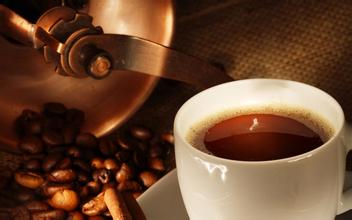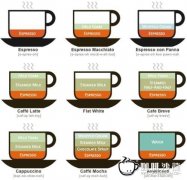Professional indicators of coffee cup testing special words for coffee cup testing

Flavor [Flavor]
It is the overall impression of aroma, acidity, and alcohol. It can be used to describe the overall feeling of coffee.
Acidity
It is all the sour and strong characteristics of coffee grown in the plateau. The sour acrid is different from bitter or sour, and it has nothing to do with pH value, but it is a fresh and lively quality that promotes coffee to exert functions such as boosting the mind and cleansing the taste.
Body [Alcohol]
Is the conditioning of coffee after drinking, in the tongue to coffee leaves some taste. Alcohol varies from light to light, medium, high, fatty, and even syrupy in some Indonesian coffees.
Aroma [smell]
Aroma refers to the aroma and aroma of coffee after conditioning. Bouquet is a less commonly used word for the taste of ground coffee. Aroma is usually specific and comprehensive. Words used to describe Aroma include: caramel, charred, chocolate, fruity, grassy, malty, rich, rich, spicy, etc.
Bitter
Bitterness is a basic taste, and the sensory area is distributed in the root of the tongue. The bitterness of dark roasts is deliberately created, but the most common cause of bitterness is too much coffee powder and too little water. Bitterness is not the assent word for sour.
Bland [Light]
Coffee grown in lowlands and usually quite light and tasteless. Coffee with too little powder and too much water will also have the same light effect.
Briny
Coffee brewed, if overheated, will produce a salty taste. Some coffee shops have coffee that tastes like this.
Earthy
Usually used to describe spicy and earthy Indonesian coffee. But these references to mud do not refer to coffee beans stained with mud taste. Some commercial coffees are mixed with cheap coffee, and the muddy taste may turn dirty, apparently because of the drying and rough processing techniques used to spread the beans on the ground.
Exotic
Coffee has a unique aroma and special smell, such as flowers, fruits, spices like sweet characteristics. Coffee grown in East Africa and Indonesia usually has this characteristic.
Mellow [Aromatic Alcohol]
Coffee is an adjective used to describe coffee with low to medium acidity and good balance.
Mild
It indicates that a coffee has a harmonious and delicate flavor. Highland latin american coffee usually described as mild. It is also a term used in coffee circles to refer to all highland coffee except Brazil.
Soft
A coffee with low acidity, such as Indonesian coffee. It can also be described as aromatic or sweet.
Sour
A taste zone located primarily on the back of the tongue and characteristic of light roasted coffee.
Spicy [Spicy]
A flavor or smell reminiscent of a particular spice. A type of Indonesian highland coffee (especially aged coffee) with a cardamon-like sweet aroma.
Strong
Technically, it describes the number of advantages and disadvantages of various tastes, or the relative proportion of coffee and water in a particular conditioning product. In colloquial usage, intense describes the intense flavor of dark roast coffee. In addition, it misleads people into the illusion that it contains a lot of caffeine. In fact, canned light coffee is high in caffeine because it contains more decaf coffee.
Sweet [Sweet]
It is a commonly used adjective, almost fruity in nature, and is also associated with alcohol. Coffee grown in the highlands of Costa Rica usually has a strong flavor.
Wild
Coffee has extreme taste characteristics. If ordinary people could not accept it, they would call it odd, but it could also be an attractive feature, depending on personal preferences.
Winy
Describe an attractive flavor reminiscent of wine. Fruity acidity and smooth body, creating a special flavor contrast. Kenyan coffee is the best example of wine flavor.
Important Notice :
前街咖啡 FrontStreet Coffee has moved to new addredd:
FrontStreet Coffee Address: 315,Donghua East Road,GuangZhou
Tel:020 38364473
- Prev

The ten most famous kinds of coffee in the world
1. Mocha coffee shows a strong New York flavor in a small cup. Preparation method: add 20ml chocolate syrup and very strong deep-fried coffee to the cup, stir well, add 1 tablespoon cream to float on top, peel some chocolate powder for decoration, and finally add some cinnamon sticks. two。 Mocha mint coffee: pour warm coffee and cold milk over cold cream
- Next

Coffee tasting method Taste belongs to a complex feeling
Taste belongs to a complex feeling. When learning to taste, we must first understand the factors of taste composition, so that we can disassemble and analyze each factor when tasting, and then we can detect more delicate taste, that is, detailed changes. Taste can be divided into three categories: odor (aroma), taste and taste. In the oral cavity, it can be roughly divided into upper odor (aroma) and middle taste.
Related
- Detailed explanation of Jadeite planting Land in Panamanian Jadeite Manor introduction to the grading system of Jadeite competitive bidding, Red bid, Green bid and Rose Summer
- Story of Coffee planting in Brenka region of Costa Rica Stonehenge Manor anaerobic heavy honey treatment of flavor mouth
- What's on the barrel of Blue Mountain Coffee beans?
- Can American coffee also pull flowers? How to use hot American style to pull out a good-looking pattern?
- Can you make a cold extract with coffee beans? What is the right proportion for cold-extracted coffee formula?
- Indonesian PWN Gold Mandrine Coffee Origin Features Flavor How to Chong? Mandolin coffee is American.
- A brief introduction to the flavor characteristics of Brazilian yellow bourbon coffee beans
- What is the effect of different water quality on the flavor of cold-extracted coffee? What kind of water is best for brewing coffee?
- Why do you think of Rose Summer whenever you mention Panamanian coffee?
- Introduction to the characteristics of authentic blue mountain coffee bean producing areas? What is the CIB Coffee Authority in Jamaica?

